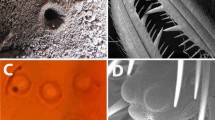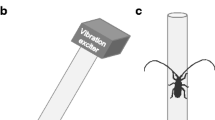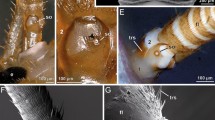Abstract
Scorpion pectines detect chemical and physical stimuli via thousands of peg sensilla on ground-facing teeth. Each sensillum has multiple neurons that detect stimuli and transmit neural impulses to the subesophageal ganglion (SEG) in the central nervous system. Anatomically, the organization of the pectinal neuropil in the SEG reflects the arrangement of pectinal teeth, suggesting conservation of information about stimulus location in the SEG. In this study, neural impulses from the pectinal nerve of the striped bark scorpion (Centruroides vittatus) were recorded in the pecten, abdominal cavity, and SEG using electrophysiology. Recordings from the right pectinal nerve in the pecten showed that right tooth stimulations elicit sensory activity milliseconds before motor feedback, while left tooth stimulations only evoked motor spikes, suggesting no contralateral afferent communication between pectines. In the abdominal cavity recordings, two distinct waveforms (PN1 and PN2) were detected in baseline activity; PN1 seemed to enhance the likelihood that PN2 would fire, suggesting a possible excitatory interaction. Recordings from the SEG showed that mechanically stimulating different pectinal teeth evoked different compound neural activity patterns in the same SEG location. Stimulating the same tooth in succession showed mechanosensory adaptation. These recordings show promise for continued electrophysiological investigations of the scorpion SEG, and, in particular, how information from the pectines is processed and used for orientation.






Similar content being viewed by others
Abbreviations
- SEG:
-
Subesophageal ganglion
- PN1:
-
Pectinal nerve spike type 1
- PN2:
-
Pectinal nerve spike type 2
- SE1:
-
Subesophageal spike type 1
- SE2:
-
Subesophageal spike type 2
References
Abushama FT (1964) On the behaviour and sensory physiology of the scorpion Leiurus quinquestriatus (H. & E.). Anim Behav 12:140–153. https://doi.org/10.1016/0003-3472(64)90115-0
Bowerman RF, Burrows M (1980) The morphology and physiology of some walking leg motor neurones in a scorpion. J Comp Physiol A 140:31–42. https://doi.org/10.1007/BF00613745
Brownell P (2001) Sensory ecology and orientational behaviors. In: Brownell P, Polis G (eds) Scorpion biology and research. Oxford University Press, New York, pp 159–183
Cloudsley-Thompson JL (1955) On the function of the pectines of scorpions. Ann Mag Nat Hist 8:556–560. https://doi.org/10.1080/00222935508655667
Foelix RF, Müller-Vorholt G (1983) The fine structure of scorpion sensory organs. II. Pectin sensilla. Bull Br Arachnol Soc 6:68–74
Gaffin DD (1994) Chemosensory physiology and behavior of the desert sand scorpion, Paruroctonus mesaensis (Scorpionida: Vaejovidae). Doctoral thesis, Oregon State University
Gaffin DD (2001) Electrophysiological evidence of synaptic interactions between sensory neurons in peg sensilla of Centruroides vittatus (Say, 1821) (Scorpiones: Buthidae). In: Fet V, Selden PA (eds) Scorpions 2001. In memoriam Gary A. Polis. British Arachnological Society, Burnham Beeches, Bucks, pp 325–330
Gaffin DD, Brayfield BP (2017) Exploring the chemo-textural familiarity hypothesis for scorpion navigation. J Arachnol 45:265–270. https://doi.org/10.1636/JoA-S-16-070.1
Gaffin DD, Brownell PH (1992) Evidence of chemical signaling in the sand scorpion, Paruroctonus mesaensis (Scorpionida: Vaejovidae). Ethology 91:59–69. https://doi.org/10.1111/j.1439-0310.1992.tb00850.x
Gaffin DD, Brownell PH (1997a) Electrophysiological evidence of synaptic interactions within chemosensory sensilla of scorpion pectines. J Comp Physiol A 181:301–307. https://doi.org/10.1007/s003590050116
Gaffin DD, Brownell PH (1997b) Response properties of chemosensory peg sensilla on the pectines of scorpions. J Comp Physiol A 181:291–300. https://doi.org/10.1007/s003590050115
Gaffin DD, Walvoord ME (2004) Scorpion peg sensilla: are they the same or different? Euscorpius 17:7–15
Ivanov VP, Balashov YS (1979) The structural and functional organization of the pectine in a scorpion, Buthus eupeus, studied by electron microscopy. In: Balashov YS (ed) The fauna and ecology of Arachnida, vol 85. Trudy Zoologicheskogo Instituta, Saint Petersburg, pp 73–87
Kladt N (2007) Neurobiology and modeling of cuticular hair sensilla of scorpions: response characteristics and implications for biomimetic design. Doctoral thesis, University of Bonn
Kladt N, Wolf H, Heinzel HG (2007) Mechanoreception by cuticular sensilla on the pectines of the scorpion Pandinus cavimanus. J Comp Physiol A 193:1033–1043. https://doi.org/10.1007/s00359-007-0254-6
Knowlton ED, Gaffin DD (2011) Functionally redundant peg sensilla on the scorpion pecten. J Comp Physiol A 197:895–902. https://doi.org/10.1007/s00359-011-0650-9
Krapf D (1986) Contact chemoreception of prey in hunting scorpions (Arachnida: Scorpiones). Zool Anz 217:119–129
Mineo MF, Claro KD (2006) Mechanoreceptive function of pectines in the Brazilian yellow scorpion Tityus serrulatus: perception of substrate-borne vibrations and prey detection. Acta Ethol 9:79–85. https://doi.org/10.1007/s10211-006-0021-7
Taylor MS, Cosper C, Gaffin DD (2012) Behavioral evidence of pheromonal signaling in desert grassland scorpions, Paruroctonus utahensis. J Arachnol 40:240–244
Wolf H (2008) The pecten organs of the scorpion Vaejovis spinigerus: structure and (glomerular) central projections. Arthropod Struct Dev 37:67–80. https://doi.org/10.1016/j.asd.2007.05.003
Acknowledgements
We thank Dr. Mariëlle Hoefnagels for her critical review of this manuscript. We also thank Marie Labonte and Tanner Ortery for the care of the scorpions, Elise Knowlton for her guidance in preliminary trials, Brad Brayfield for technical assistance, Safra Shakir for assistance with the recordings, and Kathryn Ashford for assistance with photography of the pectines. We also thank the University of Oklahoma’s Honors College for an Undergraduate Research Opportunities Program grant.
Author information
Authors and Affiliations
Corresponding author
Ethics declarations
Conflict of interest
None.
Additional information
Publisher's Note
Springer Nature remains neutral with regard to jurisdictional claims in published maps and institutional affiliations.
Rights and permissions
About this article
Cite this article
Hughes, K.L., Gaffin, D.D. Investigating sensory processing in the pectines of the striped bark scorpion, Centruroides vittatus. Invert Neurosci 19, 9 (2019). https://doi.org/10.1007/s10158-019-0228-8
Received:
Accepted:
Published:
DOI: https://doi.org/10.1007/s10158-019-0228-8




